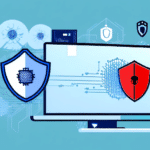Ransomware Attack on FedEx Ship Manager: How to Protect Your Business
Recently, there has been significant news coverage about the ransomware attack on FedEx Ship Manager. This incident affected thousands of small businesses that rely on the service to ship their goods. Whether you use FedEx or another shipping service for your business, it’s crucial to understand what ransomware is, how the attack on FedEx Ship Manager impacted businesses, and the measures you can take to protect your business from future ransomware attacks.
Understanding Ransomware: What It Is and How It Works
Ransomware is a type of malicious software designed to encrypt your data, rendering it inaccessible until a ransom is paid. This malware can infiltrate systems through various methods, including phishing emails, malicious websites, or infected software downloads. Once activated, ransomware encrypts critical data and demands payment for the decryption key.
One of the main dangers of ransomware is its ability to spread rapidly across networks, affecting multiple computers and systems in a short time. Recovering encrypted data without the decryption key is often challenging and sometimes impossible.
Ransomware attacks have surged in recent years, targeting both businesses and individuals. According to a report by Cybersecurity Ventures, the global cost of ransomware attacks is projected to reach $265 billion by 2031.
Preventing ransomware attacks requires a comprehensive approach, including regular software updates, the use of strong passwords, employee education on identifying phishing attempts, and maintaining regular backups of your data.
The FedEx Ship Manager Attack: Impact on Businesses
The FedEx Ship Manager ransomware attack involved the "WannaCry" malware, which had previously caused widespread damage in another notable attack affecting hospitals in the UK. In this incident, WannaCry infiltrated FedEx’s systems, encrypting the data of thousands of small businesses that depended on the service for shipping their goods.
The encrypted data included shipping information, customer details, and order records, effectively halting business operations as companies could not access the necessary information to process shipments or fulfill orders.
As a consequence of the attack, FedEx was forced to suspend its Ship Manager service for several days to contain the malware and restore its systems. This disruption had a significant impact on the businesses relying on the service, preventing them from shipping goods during the downtime.
This attack underscored the critical importance of cybersecurity for businesses of all sizes. Small businesses, in particular, often lack the resources to implement robust cybersecurity measures, making them more vulnerable to such attacks. It is essential for businesses to protect their data and systems by implementing strong passwords, regularly updating software, and training employees to recognize and avoid potential threats.
Signs of a Ransomware Attack: Detection and Response
Early detection of a ransomware attack can significantly mitigate its impact. Here are several indicators that your system may be compromised:
- Messages demanding payment for data decryption
- Inaccessible or missing files
- Slow computer or network performance
- Unusual pop-up messages or windows
If you suspect a ransomware infection, take immediate action:
- Disconnect affected devices from the network to prevent the malware from spreading.
- Contact a cybersecurity professional for guidance.
However, prevention is always superior to reaction. To safeguard your business:
- Regularly update your software and operating systems.
- Use strong, unique passwords and enable multi-factor authentication.
- Educate employees on recognizing and avoiding phishing scams.
Additionally, maintaining regular backups of your data to an external source, such as a cloud-based service or external hard drive, ensures that you can restore your data without paying the ransom if an attack occurs.
Effective Strategies for Preventing Ransomware Attacks
Preventing ransomware attacks involves implementing multiple layers of security. Here are some effective strategies:
- Ensure all software and systems are up-to-date with the latest security patches.
- Implement strong passwords and multi-factor authentication.
- Train employees to recognize and prevent ransomware attacks.
- Use email and web filters to block malicious content.
- Regularly back up your data to secure, offsite locations.
Another crucial strategy is to limit access to sensitive data. Grant access only to employees who need it to perform their job duties. This minimizes the potential spread of ransomware if an attack occurs.
Having a response plan in place is also vital. Your plan should include steps for isolating infected systems, notifying appropriate authorities, and restoring data from backups. A well-prepared response can reduce damage and facilitate a swift recovery.
Backup and Recovery: Protecting Your Data
Even with preventive measures, the risk of a ransomware attack remains. Therefore, having a robust backup and recovery plan is essential.
Ensure that you back up your data regularly and store it in a separate location that is not connected to your primary network. This approach ensures that, in the event of an attack, you can restore your data without paying the ransom.
Regularly test your backup and recovery plan to verify its effectiveness. Identifying and addressing potential issues beforehand ensures that your recovery process will work smoothly when needed.
Additionally, develop a disaster recovery plan outlining the steps your business will take in the event of significant data loss. This plan should detail how you will communicate with employees, customers, and stakeholders, as well as prioritize the recovery of critical systems and data.
Cybersecurity Best Practices for Small Businesses
Small businesses are often prime targets for ransomware attacks due to limited cybersecurity resources. Implementing the following best practices can help enhance your security posture:
- Use reputable antivirus software and firewalls to detect and prevent threats.
- Enable automatic updates for all software and systems to ensure they have the latest security patches.
- Adopt a “least privilege” approach to user access, granting employees access only to the data and systems necessary for their roles.
- Conduct regular security audits to identify vulnerabilities and areas needing improvement.
Educate your employees about cybersecurity best practices, including:
- Identifying phishing emails and suspicious links.
- Creating and managing strong, unique passwords.
- Avoiding the download of suspicious attachments or clicking on unknown links.
Implementing a data backup plan is also critical. Regularly back up your data to an offsite location or a reliable cloud-based service to ensure data recovery in case of an attack.
The Role of Employee Training in Preventing Ransomware Attacks
Employees are often the first line of defense against ransomware attacks. Comprehensive training can significantly reduce the risk:
- Teach employees how to identify phishing emails and suspicious website links.
- Provide best practices for creating and managing strong passwords.
- Guide employees on how to respond if they suspect an attack.
- Conduct regular security awareness training to keep employees informed about the latest threats and trends.
Business Continuity Planning: Responding to a Ransomware Attack
Despite preventive measures, a ransomware attack may still occur. A well-crafted business continuity plan ensures your business can continue operating with minimal disruption:
Your plan should include:
- Steps to isolate infected devices from the network immediately.
- Contact information for cybersecurity professionals and relevant authorities.
- Procedures for restoring data from backups.
- Communication strategies for informing employees, customers, and stakeholders about the incident and recovery efforts.
Having a clear and actionable business continuity plan minimizes downtime and helps your business recover swiftly from an attack.
The Financial Implications of Ransomware Attacks on Businesses
The financial impact of a ransomware attack can be devastating. Beyond the cost of any ransom payment, businesses may face expenses related to lost productivity, revenue losses, and reputational damage.
Studies estimate that the average cost of a ransomware attack exceeds $200,000, which can be crippling for many small businesses. These costs include:
- Ransom payments (though paying is generally discouraged).
- Costs of IT repairs and system restorations.
- Revenue lost due to operational downtime.
- Legal fees and potential regulatory fines.
- Damage to the company’s reputation, leading to loss of customer trust.
Understanding these financial implications underscores the importance of investing in robust cybersecurity measures to prevent such attacks.
The Future of Ransomware: Emerging Threats and Trends
Ransomware attacks are evolving, becoming more sophisticated and targeted. Emerging threats and trends to watch include:
- Ransomware-as-a-Service (RaaS): This model allows cybercriminals with minimal technical expertise to launch ransomware attacks by renting ransomware tools from developers.
- Artificial Intelligence (AI) and Machine Learning: Cybercriminals are leveraging AI to enhance the effectiveness of ransomware attacks, making them harder to detect and more capable of bypassing security measures.
- Targeted Attacks: There is an increase in highly targeted attacks aimed at specific industries or organizations, often with higher ransom demands.
- Mobile and IoT Ransomware: New forms of ransomware are targeting mobile devices and Internet of Things (IoT) devices, expanding the potential attack surface.
- Social Engineering Techniques: Attackers are using advanced social engineering tactics to trick users into unwittingly installing ransomware.
As these threats continue to advance, it is crucial for businesses to stay informed and adapt their cybersecurity strategies accordingly to protect against evolving ransomware tactics.
Conclusion
The ransomware attack on FedEx Ship Manager served as a wake-up call for businesses of all sizes. No business is immune to ransomware attacks, making it essential for every organization to take proactive steps to protect itself.
By implementing strong cybersecurity practices, training employees to recognize and prevent attacks, and maintaining a robust backup and recovery plan, businesses can significantly reduce the risk of ransomware attacks and ensure swift recovery in the event of an incident.






















